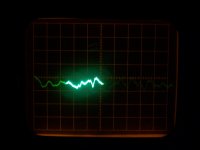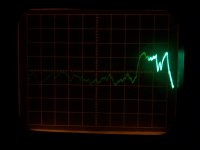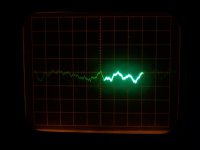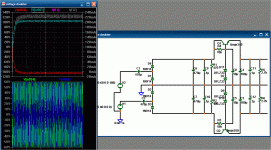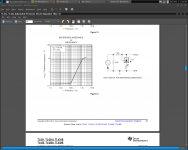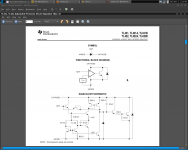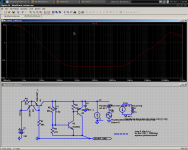I first adjusted to as close to 5V as I could get it. Looked back after time spent conspiring and building, and it was about 4.8V. Readjusted. Now it's about 4.986V.
- keantoken
- keantoken
Just a resistor looks attractive from the ultra simple POV. Say if the 470R its a trimmer, and someone fires up the amp first time, waits 15mins and adjusts to 90V. Checks in an hour and adjusts one more time and lets it be, will Vbe vary further dynamically?
The regulator has extra voltage when just turned on, then decreases as it warms up. Right now the prototype is warm but not very warm. After that, output will vary with temperature. If we use a floating inert block of metal to sink, with least surface area, it will act like a heat sponge and will absorb any quick changes in temperature, but this is obviously sub-optimal.
- keantoken
- keantoken
It may work to do this, but it will affect other areas of design. Someone will have to build the prototype and measure the drift, and see if it is tolerable.Just a resistor looks attractive from the ultra simple POV. Say if the 470R its a trimmer, and someone fires up the amp first time, waits 15mins and adjusts to 90V. Checks in an hour and adjusts one more time and lets it be, will Vbe vary further dynamically?
If I had a HV supply, I could do it with my current prototype.
- keantoken
What will be the consequences in the input & VAS stages of the amp if say works at 91V now and at 89V then? The changes will be in plateaus or there will be dynamic Vout modulation danger? Or it will be like you had Vout from a Tx, rectifier and cap, that follows the mains nominal each time? I.e. just working from a non strictly defined B+ as an absolute number each time?
Draw the pattern, with etch resistant ink. A plotter uses tiny re-fill ink bottles, bit of a hassle to locate the proper ink though.
Marker holes are not an issue with plastic spray, i've got a heated jacuzzi etch tub, the 2-stage etch job is no big deal.
I totally despise via riveting.
Laser printing isn't me cup of tea for double sided boards and i've spent loads on transparents, general use and PCB specials since their first release.
(H..., me went out eating yesterday eve, when me gots home there was no dig tv, no dig telephone, and no internet. 15hrs of tight buttocks, how come a hick as me lived to see the day i became a web junkie)
thanks for the tip, but I only have an ink printer at home and laser at work for iron on transfers. I think I will iron on one side, drill a few holes and line the other side up with the holes, dip it once, i think this should work.
WWW is certainly becoming an esential service, more for sanity than anything.
Nope, no Jfets here.
- keantoken
I am ordering FJN598JATA Fairchild Semiconductor JFET ($.10 X 10 or 15) will try to throw some your way.. (envelope)
Many ways to get HV ... doubler/Tripler , wire 2 trafo's together in series , add 2 small trafos to a larger CT one (24 - 45 - 0 - 45 - 24 / nico's trick)
OS
Last edited:
Only the low Idss ones you must send him OS. So to have the low range pinch off voltage and be stable under Kean's only Vbe voltage margin. Or he can sort the ones of 200uA-400uA idss himself.
A max drain current of 1mA? If it's compatible, it will allow for higher R5, which will mean better bass performance.
- keantoken
- keantoken
OS knows very well what he picked. Both low enough -Vp to work under Vbe and small Idss range for tighter regulation. Plus leads to bigger Rref R5 so to extend filtering lower with just a film cap. May work steady enough without hunting its best tempco even.
Say the reg starts out at 100V and drifts down to 90V. Our input voltage must exceed 100V for proper operation at start-up. +-10V won't hurt it much, but it may destroy the point of using higher upper rails, to compensate for output FET voltage swing limits.
- keantoken
- keantoken
I would need to make a voltage quadrupler to step up my 20-30V bench rails. All I have in that range are old caps of questionable integrity, and I want to avoid explosions while I still have my eyesight.
- keantoken
- keantoken
Say the reg starts out at 100V and drifts down to 90V. Our input voltage must exceed 100V for proper operation at start-up. +-10V won't hurt it much, but it may destroy the point of using higher upper rails, to compensate for output FET voltage swing limits.
- keantoken
10V would be much indeed.
LF noise! 100uV/div, 50mS/div. It is neat to watch and try to identify a pattern. Oddly enough it looks not unlike brainwave charts I've seen. We would have to see it with a spectrum analyzer...
- keantoken
- keantoken
Attachments
Say the reg starts out at 100V and drifts down to 90V. Our input voltage must exceed 100V for proper operation at start-up. +-10V won't hurt it much, but it may destroy the point of using higher upper rails, to compensate for output FET voltage swing limits.
- keantoken
I was thinking with the 60-0-60 V cheap trafo... http://www.diyaudio.com/forums/solid-state/175289-goldmund-mods-improvements-stability-56.html#post2344610 (post 560)that would rectify out to 110- 0- 110V (160v/470uF caps) , with a 470r load (220mA) , I still get 105V "dirty" DC. look at schema/plot. This is close to what the original goldmund must do with that 60VAC tap. I just would not want THAT on my power board. Offboard is preferred , I mean we are using a separate trafo anyways , why bring the trafos leads to the OPS board??
If we run the OPS at lower rails (60-70V) +/ - 80Vreg would do fine. 🙂 BTW , just ignore the crude Zener reg's. , I took the readings BEFORE them... (second pix) is the real OP of +/- 80V , 40mv ripple ..OMG! Just for laughs.. 😀
OS
Attachments
Last edited:
Try the original PSU, it had quite a bit of filtering.
- keantoken
It (the goldmund)has the equivalent of my mongrel cap multiplier after the doubler. all I had to do was increase the 10uF's to 100uF or more .... about 1 mV after. My point was that there is plenty of voltage to play with , OVER 120V w/ no load and that the regulator will have to deal with 5V ripple by default. (Big 160V caps are costly)
OS
MiiB, the TL431 is slower and has lower impedance. About the only improvement is in bass, and if it's that important we can substitute zeners for R5.
These comparisons might help you decide which is more appealing.
- keantoken
These comparisons might help you decide which is more appealing.
- keantoken
Attachments
- Home
- Amplifiers
- Solid State
- Goldmund Mods, Improvements, Stability
